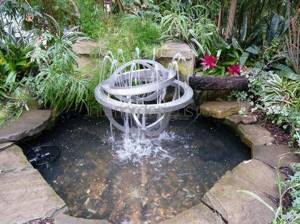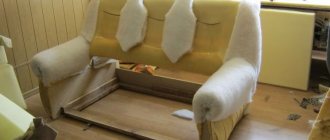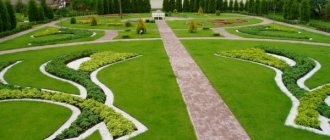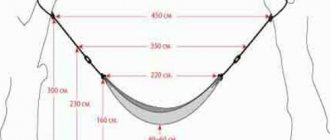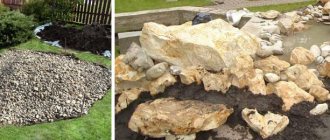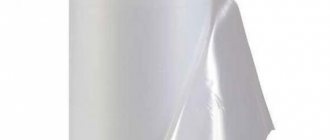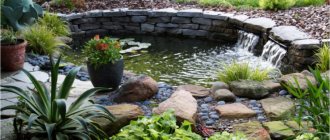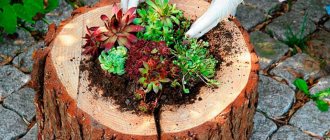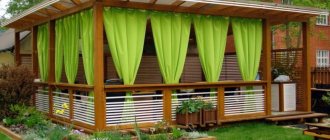Fountain pumps
You can do without a pump if there is a centralized pressure water supply on the site. Water is conducted into the tank and released from a vertically installed pipe with a sprayer attached to it. Its excess is sent through the drain pipeline to the sewer or to water the garden. Or they are pumped into a storage tank using a pump.
But constant operation of such a fountain is impossible: you can admire it only for a short period of time while watering occurs or the container is filled. Therefore, a more common and simpler way to make a fountain with your own hands at the dacha is to install a special pump in a water tank, which sucks in water through a filter and then throws it out through the outlet pipe with a spray nozzle installed on it.
Fountain design diagram Source stroychik.ru
Types of fountain pumps
When choosing a pump, you first decide on the type of installation: in the tank itself or outside it, “on land”. Accordingly, it must be submersible or surface.
- Submersible pumps.
They are usually characterized by low power, low energy consumption, quiet operation and affordable price. And ease of installation and operation, since you can make a fountain in the yard without the use of hoses and pipes.
Such pumps are equipped with a platform or suction cups for installation on the bottom Source fontan-shop.ru
- Surface pumps.
Such units are more powerful and noisier. They are installed next to a reservoir, and to suck water from it, a hose or pipeline with a filter at the end is pulled. The second hose with a nozzle is returned from the pump to the reservoir or laid on the top of the cascade when constructing a fountain with a waterfall.
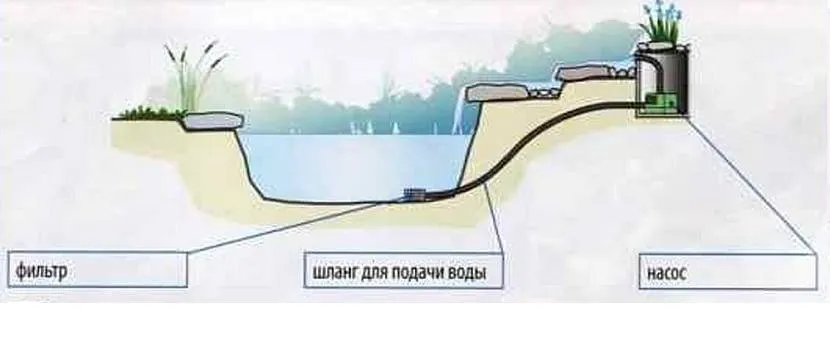
Waterfall design diagram Source i.ibb.co
Surface pumps need protection from the sun and precipitation, so they are placed in a nearby room, a specially made caisson, or covered with a casing. They are more difficult to install and more expensive, but these disadvantages are compensated by high power, reliability, durability and ease of maintenance.
Advice! Having thought about how to build a fountain, you need to immediately decide on its size, the depth of the tank, the desired height of the water column in order to select a pump with the required power, pressure and other parameters.
See also: Companies that specialize in landscape design and gardening.
Types of nozzles
Most fountain pumps are equipped with flow regulators and a set of interchangeable nozzles, with which you can change the type of stream and its intensity to your taste.
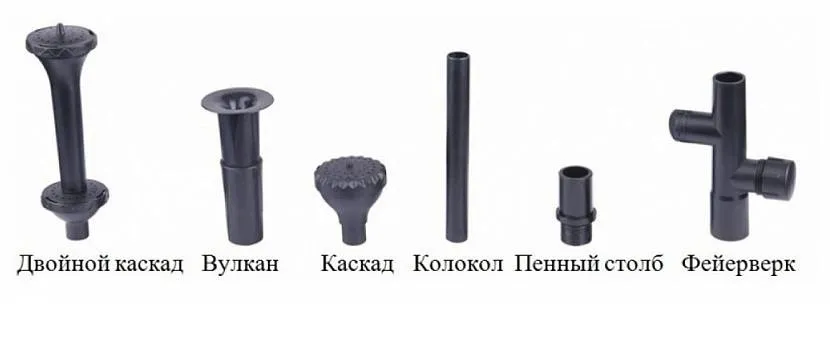
Main types of fountain sprayers Source i.ibb.co
They can be single or multi-tiered, releasing thin jets and forming a continuous water wall in the form of a hemisphere or fish tail. Geyser nozzles create bubbles similar to soap bubbles, and distribution manifolds in the form of an arc with pipes release several jets at once, located in a circle.
When equipping a fountain in the yard with your own hands, how to make it as effective and diverse as possible is decided with the help of such nozzles. They can be purchased separately, choosing products with a connection diameter corresponding to the pressure pipeline.
Choosing a place for a fountain
The correct location of the fountain not only ensures maximum decorativeness of the structure, but also makes it easier to care for during operation. If the fountain is located in a completely open area, which is actively heated by the sun, the water will evaporate and bloom faster.
You cannot build a pond with a fountain next to trees and deciduous shrubs. Firstly, this will lead to damage to the pond bowl by the roots, and secondly, leaves, small twigs and other debris will get into the water. In such conditions, filters quickly become clogged and fail, and the water becomes cloudy and acquires a putrid odor.
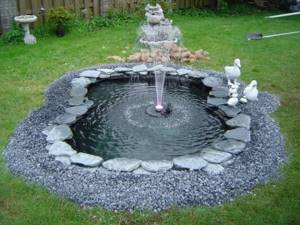
Choosing a location for a fountain is of great importance
The fountain should be located on the leeward side and no closer than half a meter from buildings and garden furniture. Due to splashes and water spray, the surfaces will always be wet, which will lead to the development of fungus and the gradual destruction of materials. But you shouldn’t place the fountain too far from the house either. Electricity is required to connect the pump, and a cable that is too long causes additional inconvenience and expense. A backlit fountain looks very impressive, and for this it is also necessary that the energy source be at the optimal distance from the reservoir.
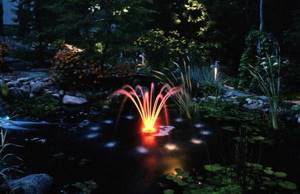
The illuminated fountain looks very impressive
And last but not least, the fountain must have a decorative background and be clearly visible from different corners of the site. It makes no sense to install such a structure if there is no opportunity to admire it and show it to guests.
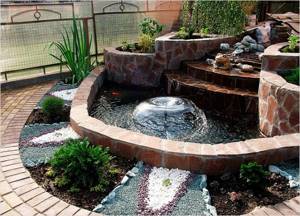
A decorative fountain should be located in a visible place
Tanks, reservoirs and reservoirs
The size of the structure can be very different. It is from the desired dimensions that you need to start when choosing a bowl. If you are thinking about how to make a small fountain in the country with your own hands, a large flowerpot mounted on a pedestal, or even an ordinary basin dug into the ground and decorated around the circumference with pebbles, is suitable for this. All that remains is to fill it with water, lower the pump and connect it to the network.
For a more solid structure, you can also choose a tank by purchasing a ready-made one in a store or by adapting an old bathtub. Finished containers are made of plastic and composite materials. The former are cheaper, but are not highly durable, the latter are more expensive, have considerable weight, but last a long time.
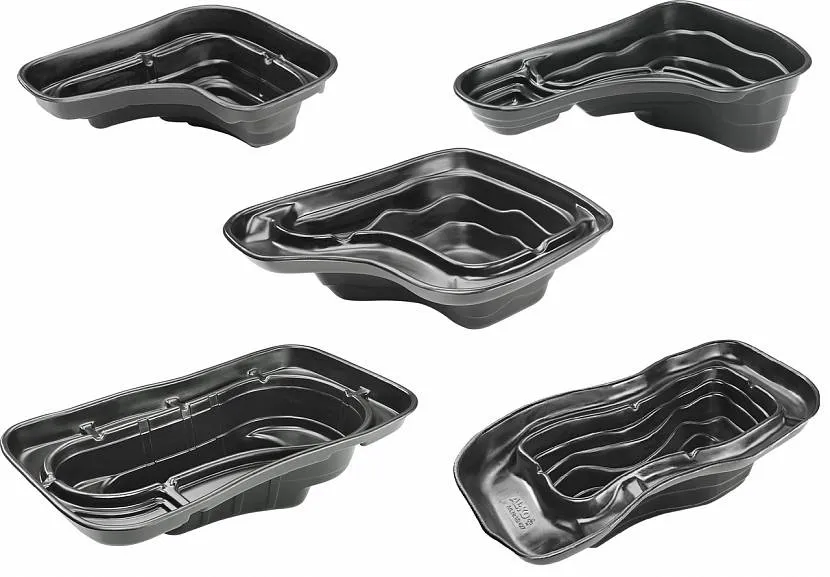
The container for the reservoir can be chosen in any shape and size Source prom.st
Manufacturing fountains from marble and granite to order at KAM Group of Companies
Do you want to buy a fountain made of marble or granite? Welcome to KAM Group!
In our company you can order the production, delivery and installation of a fountain made of natural stone, and purchase special products for caring for the stone surface.
Call or send a request through the form. Come to our office showroom.
—
Marble fountains

Marble fountains decorate respectable buildings around the world. This is one of the traditional finishing materials, ideal for creating complex sculptural compositions and delicate decorations. It is distinguished by a richness of textures and natural shades.
The most common marbles are grey, black and white, but shades of brown, pink, yellow, blue and green are also possible.
In our collection: 200 types of marble
Order an estimate
—
Granite fountains
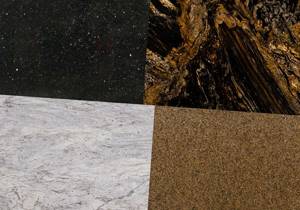
Granite is a reliable, durable, durable material associated with monumental sculptures. The popularity of granite is explained by the ideal fusion of beauty, performance characteristics and reasonable cost. It is suitable for the manufacture of all types of fountains and the implementation of projects of any complexity and size.
Granite retains its original appearance for decades under prolonged exposure to ultraviolet radiation and contact with water.
In our collection: 102 types of granite
Order an estimate
—
To buy a garden fountain for your dacha, order a park, street, interior, wall fountain made of marble and granite, as well as for advice on all types of products, contact the specialists of KAM Group by phone or send a request through the form on the website.
—
Video description
The installation of a tank for a decorative pond and fountain is shown in the video:
Making a bowl with your own hands
If you can’t find a suitable container in the store, you can take a different approach to the question of how to build a fountain in your dacha with your own hands. To do this, you will need sand, geotextiles and pool film or regular thick polyethylene film (it is cheaper):
- First, a pit of the required size and depth is dug.
- After removing roots, stones and other protrusions, the bottom is carefully compacted and covered with sand.
- Then the pit is completely covered with geotextiles to prevent plant germination.
- The film is laid loosely on top of the geotextile. It should not be pulled, and the edges should extend to the surface of the ground at least 25 cm.
- Along the perimeter, the edges of the film are pressed with boulders; pebbles and rounded stones without sharp edges that can damage the waterproofing are also placed on the bottom of the bowl.
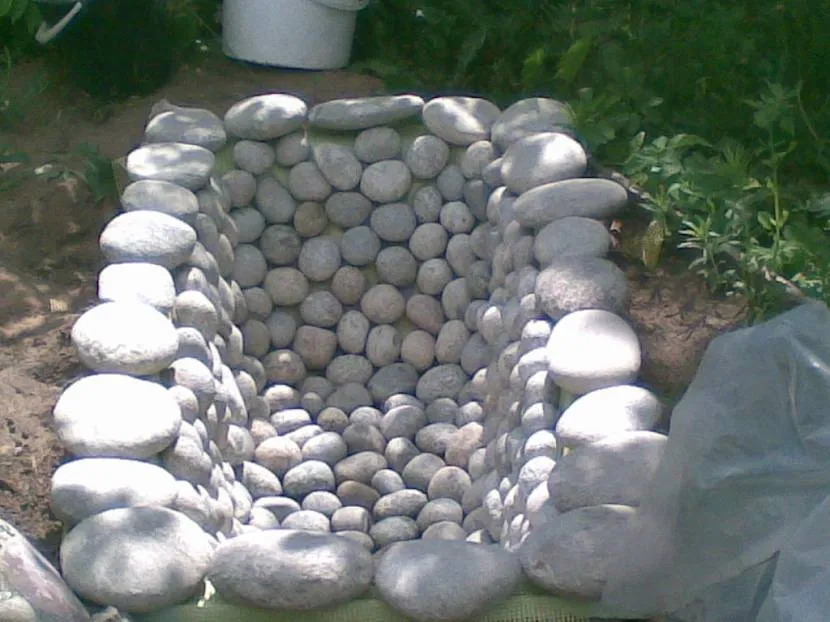
Ready reservoir for a fountain Source i0.wp.com
Making a fountain with your own hands
There are a lot of options for homemade fountains - from the simplest and most compact to complex multi-level designs with lighting and figured interlacing of jets. Let's consider one of the available methods, which does not require large expenses and at the same time looks very decorative.
Preparing the bowl
First, you need to think about the shape and size of the future reservoir and select a suitable site for it on the site. Next, you should clear the area and make markings, marking the contours of the bowl on the ground.
Step 1. The soil is excavated inside the marking. The optimal depth is 40-50 cm, but everyone selects this parameter depending on their preferences.
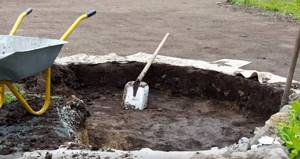
Excavation according to markings
Step 2. It is recommended to carefully align the walls and bottom of the pit so that the waterproofing lies more evenly.
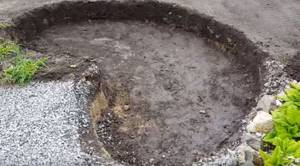
The bottom and walls of the pit must be smooth
Step 3. A sand cushion with a thickness of at least 5 cm is poured onto the bottom. The sand must be leveled and compacted well.
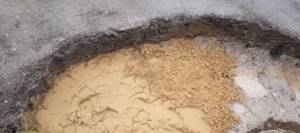
The bottom is covered with a layer of sand
Step 4. High-density polyethylene film is laid on top of the sand. The edges of the film should extend beyond the contours of the pit so that the walls are completely covered. If a solid piece of polyethylene is not enough, several strips are used, which are laid with an overlap of about 15 cm. It is better to lay a thin film in several layers for a more reliable sealing of the reservoir. The waterproofing material is temporarily pressed to the ground with stones along the edges and along the walls.
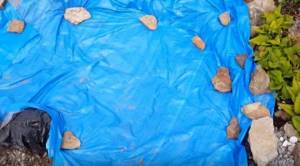
Pit waterproofing device
Step 5. On top of the film you need to pour a layer of fine crushed stone or gravel, which must be clean, that is, without any admixtures of clay or earth. Otherwise, the water will have to be changed several times to achieve transparency of the reservoir. There is no need to sprinkle film on the area where the fountain is installed.
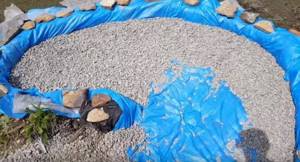
Backfilling the base with crushed stone
Step 6. An ordinary plastic bucket with a capacity of 10 liters can be used as a water collector and base for the pump. To do this, you need to drill holes in its walls along the entire circumference with a feather drill.
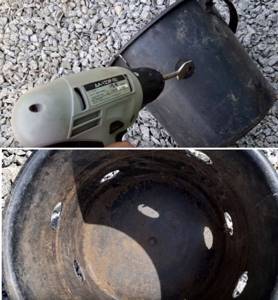
You need to drill holes in the bucket
Step 7. The prepared bucket is placed on the film and leveled horizontally. If the base for the pump is skewed, this will negatively affect the decorative effect of the fountain, because the jets will also be directed at an angle.
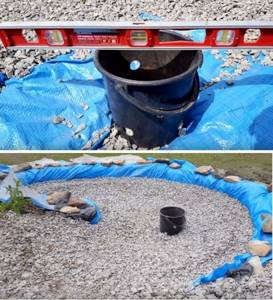
The bucket is leveled
Step 8. It is recommended to lay large stones around the perimeter of the bowl of the future reservoir. This will give the pond a more picturesque look.
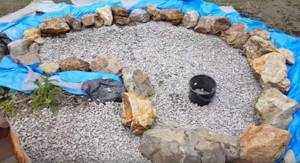
Laying stones around the perimeter of the bowl
Important! Before laying, the stones should be washed thoroughly to remove adhering soil, clay and small debris. Otherwise, all this will fall into the water, and the pond will turn into a big puddle.
Step 9. The second row of stones is laid on top, and the film protruding from under them is carefully trimmed. Gaps between large boulders should be filled with smaller stones.
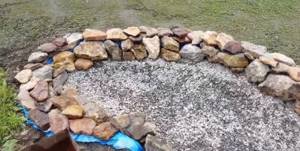
The film should not be visible from under the stones
Step 10. The remaining medium-sized stones can be placed in random order on the bottom of the future pond. They will look attractive in clear water.
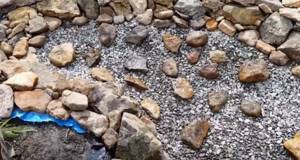
Decorating the bottom of the pond with stones
Fountain device
The preparation of the bowl is completed; decoration can begin only after installing the fountain. Installation of the equipment is quite simple.
Step 1. To increase the stability of a homemade water collector, you need to pour a little crushed stone inside to create a layer 5-7 cm thick.
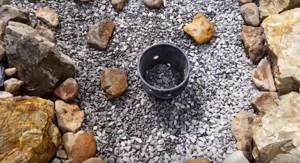
For stability, crushed stone is poured into the bucket
Step 2. The pump is lowered inside the bucket. It should turn easily in the container, and not enter with force, otherwise its maintenance will be difficult.
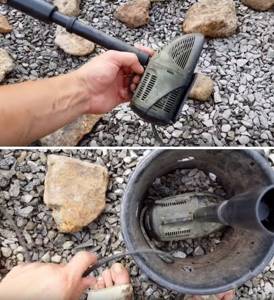
Installing a pump in a bucket
Step 3. The end of the wire from the pump must be taken out of the pond, while the wire itself must pass freely along the bottom, without tension.
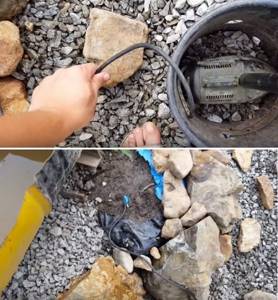
The wire is led outside the pond
Important! The wire must have high-quality insulation, since it will constantly be under water. Before laying, you should carefully inspect it along its entire length and make sure there is no damage.
Step 4. The water collector with the pump is laid on the outside with stones so that only the nozzle remains on the surface.
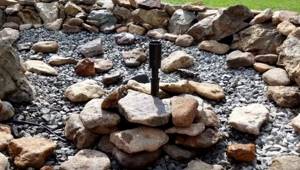
The drainage basin is completely filled with stones
Step 5. Now all that remains is to connect the pump. It is necessary to dig a trench under the cable from the building where the distribution panel is located to the reservoir. There is no need to dig deep - the main thing is to hide the wire so that it does not interfere with walking. It is advisable to thread the cable through the corrugation and only then install it.
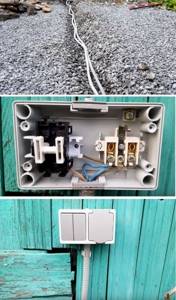
Pump connection
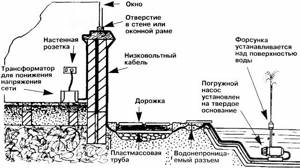
Diagram for connecting the pump to the network
Step 6. You can start filling the bowl with water. To prevent the stream from washing away small pebbles at the bottom, it is recommended to direct the water supply hose to the water collector.
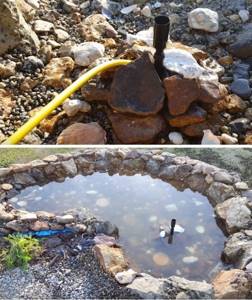
Filling the pond with water
After filling the reservoir, you can check the operation of the fountain. Many additionally install lighting, which gives the pond a cozy look at night. In our case, a lantern is mounted on the shore of the pond, and the cable from it is laid together with the cable from the pump in the same trench.
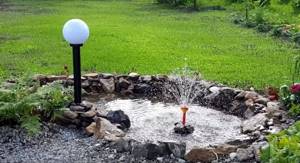
Ready pond with fountain
If it is necessary to adjust or replace the pump, it is enough to disassemble the top row of stones covering the bucket. You can change the appearance of the fountain using various nozzles, which are now available in a wide range.
Waterfall device
It is a little more difficult to solve the problem of how to build a fountain in a country house with a waterfall. Additional work will have to be done, namely:
- build a cascade of stones on the edge of the reservoir;
- lay a pipe from the pump outlet to its top.
The cascade can also be bought ready-made or made from large stones, secured with cement mortar.
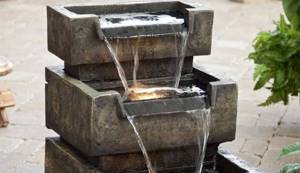
Ready-made design for a waterfall Source i.ibb.co
During the process of laying the cascade, a pressure hose from the reservoir must be laid between the stones if a submersible pump is used. Or the suction pipeline of a surface unit, for which it is necessary to immediately prepare a place protected from precipitation.
Features of finishing fountains with natural stone
Among the activities of the KAM Group of Companies, finishing fountains with stone occupies an important place. It is natural stone that has remained the most popular and indispensable material for finishing these products for many centuries. The secret of its popularity is simple - a high degree of aesthetics with excellent physical properties and performance characteristics.
The stone perfectly withstands the effects of water for decades. At the same time, it is easy to process and you can create impressive artistic compositions from it.
Each fountain made of natural stone is unique and inimitable, since the structure, shade and pattern of the material are always different. Over many centuries, finishing methods have remained virtually unchanged. But modern technology came to the aid of specialists, making it possible to perform processing with better quality and greater subtlety.
—
Briefly about the main thing
Before you build a fountain with your own hands, you need to think about its parameters: the size and depth of the bowl, the height to which the water column should rise, the method of decoration. Then you can buy or build a water tank yourself and select a pump. To install a finished bowl, just dig a pit under it and add a layer of sand. A homemade pond is waterproofed with geotextiles and film. To install a fountain, you can purchase a submersible pump and install it at the bottom. Surface mechanisms are placed on the shore and a suction and pressure pipeline is connected to them.
Ratings 0
Construction of a fountain without a pond
If it is not possible to create a pond, or you simply don’t want to take care of it, the fountain can be installed without it. Properly selected design will allow such a fountain to become a real decoration of the site. All work can be completed in a day; it does not require any special skills.
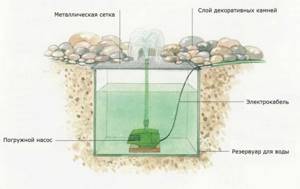
Diagram of a fountain without a pond
To make a fountain you will need a plastic bowl, a submersible pump, a filter, a thick film, a metal mesh with small cells, as well as sand and stones for decorating the structure.
Table. Making a fountain with your own hands:
| Illustration | Description of work |
| Step 1 | A circle is marked on the selected site with a diameter twice the diameter of the bowl. Soil is selected to a depth of 10 cm, and then a hole the size of a plastic container is dug in the center of the circle. |
| Step 2 | In the hole you need to make a sand cushion on which the bowl is installed so that its edges rise above the surface by about 5 cm. Be sure to control the horizontal position of the container during installation. After this, water should be poured into the bowl, without adding 4-5 cm to the edges. |
| Step 3 | A submersible pump is inserted into a bowl of water, a nozzle is put on it and the water supply is checked. It is very important to adjust the pressure so that all the water falls back into the container and does not splash around. |
| Step 4 | A circle is cut out of the film along the diameter of the entire recess, cuts are made in the center so that the edges of the film fall into the bowl and completely cover its edges. |
| Step 5 | Several metal rods are placed on the film at some distance from each other, and a mesh with a slot for the nozzle is placed on the rods. |
| Step 6 | The fountain is decorated: large and small stones, pebbles, and shells are laid out on the mesh. The stones should completely hide the mesh. Plants can be planted around the perimeter. |
The wire from the pump is laid in a trench and also covered with pebbles or gravel on top. With the onset of cold weather, the water from the tank must be drained, the pump disconnected from the cable and put away for the winter. It is also recommended to cover the area with film or other material to prevent debris from accumulating between the stones.
To make a fountain, you can use any containers: barrels, flowerpots, old unnecessary bathtubs, and so on. This offers ample opportunities to show your imagination and creative approach.
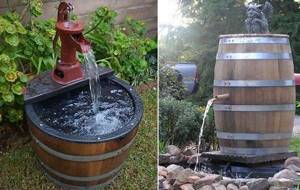
A barrel fountain is an excellent solution for a rustic garden
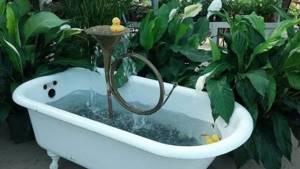
Successful use of an old bathtub
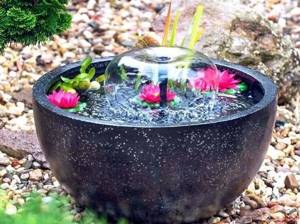
Small fountain in a concrete bowl
A pond in a suburban area may not have a fountain: if designed correctly, it will look quite picturesque. In addition, it simplifies the work and takes less time.
Types of fountains
- Dry spring. The jet circulates in a circle. It flows into the container and from there returns to its original position.
- Submersible fountain. This object takes water from the reservoir in which it was installed.
- Decorative structure. The name speaks for itself. It creates a beautiful effect with a stream of water. The decorative fountain is considered one of the most popular among all types.
- Construction with a special effect. Thanks to the built-in electronic control, the fountain not only plays melodies, but also attracts with different color shades
- The fountain is interactive. The built-in remote control allows you to control and select the color scheme and water supply height.
You can decorate your garden plot with garden fountains in completely different themes. The developers have tried their best and offer their product, which has different attachments so that the flowing stream of water creates patterns.
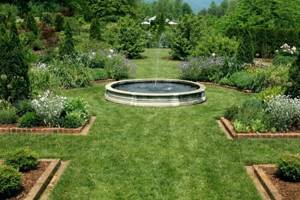
Several ways to turn an ordinary fountain into something special
Depending on the shape that the outlet stream takes, the following types of fountains are distinguished: simple “jet”, “hemisphere”, “tulip”, “bell”, “ring” and “fishtail”. Due to their simplicity, jet fountains are most widespread.
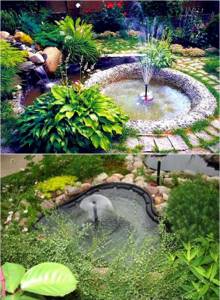
A mini fountain for a garden can become a real work of art with the help of additional equipment such as lighting and special attachments. By selecting spray nozzles, you can create unusual shapes of water streams: in the form of a dome, a flower bowl, a foam column, a pyramid, a funnel, a fan.

In addition, you can use a group of fountains with different nozzles to create a spectacular composition.
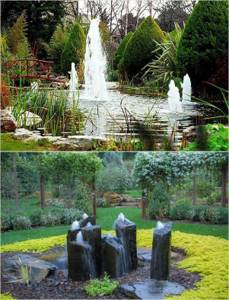
In addition, do not forget that your garden fountain can be additionally decorated with various figures and structures made of stones that will spew out streams of water.
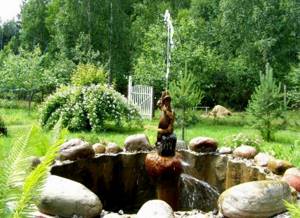
A fountain with lighting looks romantic, which is available in three variations: constant monochromatic, multi-colored and changing dynamic. The choice depends on the budget and individual preferences. Illumination for ponds is made of LED lamps. You can buy a solar-powered lighting system, which is not only safe, but also economical.
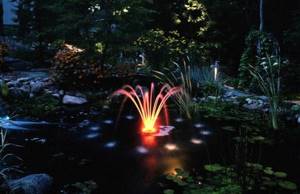
In large gardening stores you can buy complete sets of country fountains, completely ready for installation. The price for them depends on the composition of the kit, dimensions and performance of the pump. A submersible installation with additional nozzles and medium-power LED lighting will cost from 5 - 6 thousand rubles. At the same time, the kit necessarily includes all the connecting elements and installing it will not be difficult.
If it is not possible to run a power cable to operate the pump, you should consider purchasing a stand-alone device with a photocell. A solar-powered fountain for a garden pond has two types of devices: those with photocells built into the bowl and those placed on the panel.
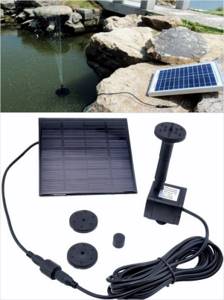
The second type of device is convenient when, to gain access to sunlight, it is necessary to place the batteries at a distance from the reservoir. The minimum cost of such a kit is 1.5 thousand rubles.
Sets of floating fountains, which are suitable for reservoirs of any depth and are easy to install, are very popular on country ponds. By design, they are equipped with a float, and to permanently fix them in a certain part of the pond, an anchor or guy wire is used.
In addition to inexpensive country models, the market offers powerful floating fountain installations for natural reservoirs with significant depth, the cost of which is several tens of thousands of rubles.
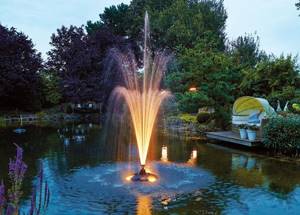
Indoor fountain
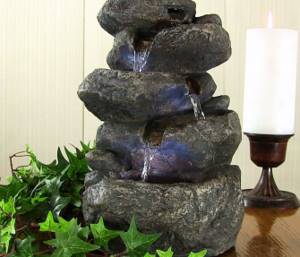
Small fountains for installation in an apartment work on a similar principle, but they use very small pumps. They work very quietly. For an oriental style fountain you will additionally need:
- oval ceramic container;
- bamboo 70 cm long;
- a bunch of living bamboo;
- small decorative pebbles.
Bamboo is cut into several pieces of different lengths. The upper cut is made obliquely, and the lower one is left straight. On the longest part, a “joint” is left at a height of 0.5 cm from the lower end. A pump is placed in a ceramic container. The longest bamboo tube is put on it. On the other side, a living plant is placed. The free space is filled with stones. The remaining pieces of bamboo are tied to the first one with coarse hemp rope. Then pour water and check the operation of the device.
Ideal location for a fountain in a country house
The most suitable place for constructing a fountain is considered to be one that is clearly visible from all points of the garden area. Another option is to be located in a recreation area - near a gazebo, open veranda, etc. - so that you can admire the source during a family vacation.
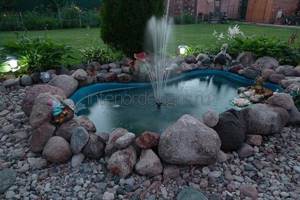
In addition to good visibility, when choosing a location for an architectural element, it is worth considering the following aspects:
- presence of slope. Experts recommend constructing the structure in a low-lying part of the site; in this way it is possible to increase the saturation of the air with moisture, which will create favorable microflora;
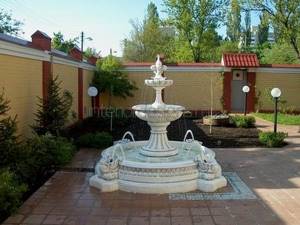
— presence of trees and shrubs. It is rational to locate the source at some distance from trees and other vegetation, otherwise leaves, bark, fluff and midges will clog the water. Moreover, powerful tree roots can damage the waterproofing of the source;
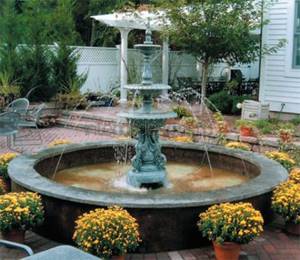
- presence of buildings. It is not advisable to install the bowl near the house and outbuildings so that wind currents do not transfer moisture to the walls (to avoid the formation of mold and fungi);
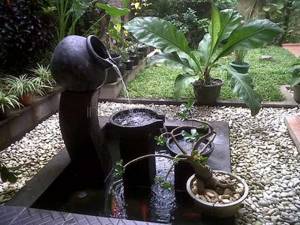
— access to the engineering system. The oasis should be located in a place on the site where all engineering systems (plumbing, electricity) can be freely connected.
